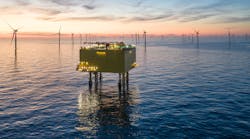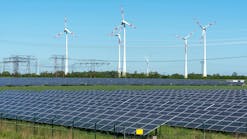One of the things that really is exciting about following technologies is their ability to change, advance and have branches grow into mainstream applications that shakeup the established status quo of the industry. That is exactly what is happening with wind generation, which has been a major player for decades. Actually, it’s the portion of wind generation technology known as offshore wind generation.
This subdivision has been around for many years, but it has been more of a niche market. Now it’s moving to center stage in the marketplace. Cutting-edge engineering and advancements in material science have improved every aspect of wind generation along with remote monitoring and maintenance systems improvements. These enhancements have enabled offshore windfarms to move further from shore and into deeper waters.
Also floating platforms are attracting attention, which opens up deeper waters with better wind resources. Still, offshore wind generation is considered an untapped resource by the experts. Some authorities argue that wind generation itself is underutilized, but the statistics tell a different story.
2020 (the latest figures available) saw nearly 93 gigawatts (GWs) added to the global wind generation capacity despite the COVID-19 pandemic. That 93 GWs made 2020 a record breaking year for additions to global wind generation. It also brought the cumulative global capacity of wind generation up to approximately 743 GWs.
Offshore Potential
Of that total 743 GWs, only about 35.3 GWs comes from offshore wind facilities, but that is changing if the orders in the pipeline are any indication. The final figures for 2021 aren’t in yet, but GWEC’s (Global Wind Energy Council) annual report predicts about 12 GWs of offshore wind will be added in 2021.
This seems to be supported by a DOE (Department of Energy) report using material from 4C, an independent marine consultancy, and BloombergNEF, which forecast the cumulative offshore capacity will increase to roughly 215 GWs over the next decade. These and other projections show there’s too great a demand to ignore this segment.
Offshore wind offers some advantages over onshore breezes. They are more constant, so the generated electricity has less intermittency. Also wind speeds tend to be faster than on land, which increases electricity produced. It also helps that megawatt/hour costs have decreased because offshore wind turbines are larger than their land-based counterparts..
In today’s world, the term large turbines means turbines in the 14 to 16 megawatt (MW) range with 20 MWs turbines being in the foreseeable future. GE Renewable Energy has its 14 megawatt (MW) Haliade-X turbine, MingYang will be offering their 16 MW MySE 16.0-242 turbine this year, Siemens Gamesa has its 14 MW SG 14-222 DD, and Vestas Wind Systems said their 15 MW V236-15.0 protype will begin testing this year.
Not Your Grandpa’s Windfarm
These 21st century wind turbines are boosting the capacities of modern windfarm projects, making them vastly different from previous generations. Facilities are now running in the 2 to 4 GW range, which makes a phased approach more desirable when it comes to building them.
Some interesting examples are the 4.9 GW Hornsea Project, 3.6 GW Dogger Bank, and the proposed 4.1 GW Berwick Bank to name a few. Another change is how far the offshore projects are moving out to sea. It’s not unusual to find them well beyond 50 miles (80 km) from shore.
Talking with Anthony Allard, executive vice president, head of Hitachi Energy North America revealed some interesting details about the tug-of-war between HVAC and HVDC connections for large remote windfarms. Allard said, “Most of the offshore projects in the U.S., so far use AC transmission, and there are some good reasons for this, because the projects are close to shore. However, as these offshore wind facilities move farther from shore, they add to the complexity of the logistics of getting the power onshore and connected to the grid. Hitachi Energy has over 20 years of experience with offshore windfarms in the North Sea and has found many advantages using HVDC to connect the more remote windfarms to the grid rather than HVAC.”
Allard continued, “While HVAC may have lower initial cost, HVDC systems using voltage source converter (VSC) technology offer several benefits that make the choice more cost effective such as more efficient operation and higher control capabilities for remote locations. This makes wind power more grid friendly by reducing losses and improving voltage and frequency stabilization. In addition, the onshore interconnection point is sometimes located at electrically weak points along the coastline, but VSC technology has no problem supporting the grid at weak interconnection points.”
Allard went on to say, “Another issue when using HVAC technology for distant offshore windfarm connections is the need for power electronics like SVCs (static VAR compensator) or STATCOMs (static synchronous compensators) to keep system voltage within acceptable levels. HVDC VSC facilities can supply voltage regulation and reactive power support without these additions.”
Onshore Challenges
Recently, speculation has run rampant when it comes to the U.S. offshore wind market. It is being fueled by all the headlines concerning the infrastructure bill signed into law. Some authorities think it will only help the administration’s plans for adding 30 GWs of utility-scale offshore wind projects. Others see only the challenges this will bring, and it’s not without some validity.
The most favorable wind project sites are where the coastal grid’s interconnection points are more distribution than transmission. What transmission there is, is mostly sub-transmission. With this predominance of sub-transmission and distribution in so many prime coastal locations, there’s every reason for some serious concerns when comes to adding these mega-windfarms to this environment.
With all of these factors in mind, a recent conversation with Hauke Jürgensen, senior vice president high voltage at Siemens Energy helped focus on some basic issues. Jürgensen said, “Offshore windfarms are connected to the grid either by HVAC or HVDC technologies and deciding which one to use can be a complicated process. HVDC technologies are more efficient than HVAC technologies for the transmission of electricity for distances over about 100 km (62 miles). An HVDC transmission link using submarine cables over a long distance has energy losses of typically less than three percent in total.”
Jürgensen pointed out, “Offshore wind facilities are running out of suitable interconnection points in many of the places developers wish to connect. Bringing cables onshore has created cable congestion in Europe with all the North Sea windfarms. Typically HVDC submarine transmission requires less cabling to carry the same amount of power as HVAC, which is significant as offshore windfarms grow in capacity. Also, there are no limitations to cable length for HVDC submarine cable systems and reactive compensation isn’t needed, which helps in congestion management by removing circuit elements.”
Jürgensen went on, “In the U.S. both the east coast and west coast are already densely populated at desired interconnection points where many of the proposed windfarms wish to come ashore. One possible solution to ease onshore visual impacts are to use HVDC gas insulated switchgear (GIS).”
Continuing, Jürgensen said, “GIS has a smaller footprint both offshore and onshore, and that can be critical in congested onshore locations where space is limited. With this technology, transition stations can even be located underground to improve the visual impact of the necessary electrical infrastructure additions.”
Enter Big Oil
With only 35.3 GWs of cumulative offshore wind generation in service, it’s truly an untapped resource, but there’s promise that’s changing. There has been a great deal of interest from big oil in offshore wind. After all, oil companies have been extracting oil and gas for decades from offshore locations, and offshore winds seems like a natural diversification.
Companies such as BP, Equinor (formerly Statoil), Royal Dutch Shell, Total, and others are investing heavily in seabed leasing and offshore wind project development, which is driving up the prices bid for premium wind sites. Non-oil wind developers don’t like the rising prices, but acknowledge the oil companies are positioning themselves to be significant players in the wind power market.
Last year, the partnership of Equinor and BP announced they were developing the Empire Wind 1 and 2 offshore wind project with a total capacity of about 2.1 GWs capacity. It’s about 30 miles (48 km) southeast of Long Island. The partnership also announced they were developing the Beacon Wind offshore project with a total capacity of more than 2.4 GWs, which is located about 60 miles (96 km) east of Montauk Point.
These are only a few of the projects under development in the offshore market, and the global list is growing at a fast clip. It’s a pretty safe bet this segment is going to grow. It will be interesting to see if the projections of 215 GWs for cumulative offshore generation will be met in the next decade. Power electronics is the key to bringing more offshore power onshore. Whatever is going to happen is really going to be interesting!


